Predicting Diagnostic Gene Biomarkers Associated With Immune Checkpoints, N6-Methyladenosine, and Ferroptosis in Patients With Acute Myocardial Infarction
- PMID: 35224064
- PMCID: PMC8873927
- DOI: 10.3389/fcvm.2022.836067
Predicting Diagnostic Gene Biomarkers Associated With Immune Checkpoints, N6-Methyladenosine, and Ferroptosis in Patients With Acute Myocardial Infarction
Abstract
This study aimed to determine early diagnosis genes of acute myocardial infarction (AMI) and then validate their association with ferroptosis, immune checkpoints, and N6-methyladenosine (m6A), which may provide a potential method for the early diagnosis of AMI. Firstly, we downloaded microarray data from NCBI (GSE61144, GSE60993, and GSE42148) and identified differentially expressed genes (DEGs) in samples from healthy subjects and patients with AMI. Also, we performed systematic gene ontology (GO) and Kyoto Encyclopedia of Genes and Genomes (KEGG) analyses and used STRING to predict protein interactions. Moreover, MCC and MCODE algorithms in the cytoHubba plug-in were used to screen nine key genes in the network. We then determined the diagnostic significance of the nine obtained DEGs by plotting receiver operating characteristic curves using a multiscale curvature classification algorithm. Meanwhile, we investigated the relationship between AMI and immune checkpoints, ferroptosis, and m6A. In addition, we further validated the key genes through the GSE66360 dataset and consequently obtained nine specific genes that can be used as early diagnosis biomarkers for AMI. Through screening, we identified 210 DEGs, including 53 downregulated and 157 upregulated genes. According to GO, KEGG, and key gene screening results, FPR1, CXCR1, ELANE, TLR2, S100A12, TLR4, CXCL8, FPR2 and CAMP could be used for early prediction of AMI. Finally, we found that AMI was associated with ferroptosis, immune checkpoints, and m6A and FPR1, CXCR1, ELANE, TLR2, S100A12, TLR4, CXCL8, FPR2 and CAMP are effective markers for the diagnosis of AMI, which can provide new prospects for future studies on the pathogenesis of AMI.
Keywords: acute myocardial infarction; diagnostic gene biomarker; differentially expressed genes; ferroptosis; immune checkpoints; m6A.
Copyright © 2022 Tong, Zhao, Dang, Kou and Kou.
Conflict of interest statement
The authors declare that the research was conducted in the absence of any commercial or financial relationships that could be construed as a potential conflict of interest.
Figures

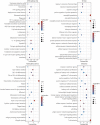


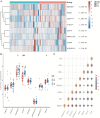
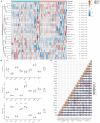
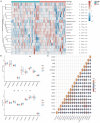
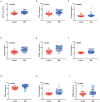
Similar articles
-
Inflammation and Oxidative Stress Role of S100A12 as a Potential Diagnostic and Therapeutic Biomarker in Acute Myocardial Infarction.Oxid Med Cell Longev. 2022 Aug 25;2022:2633123. doi: 10.1155/2022/2633123. eCollection 2022. Oxid Med Cell Longev. 2022. Retraction in: Oxid Med Cell Longev. 2023 Dec 29;2023:9789872. doi: 10.1155/2023/9789872. PMID: 36062187 Free PMC article. Retracted.
-
Biomarkers Associated with Immune Checkpoint, N6-Methyladenosine, and Ferroptosis in Patients with Restenosis.J Inflamm Res. 2023 Feb 2;16:407-420. doi: 10.2147/JIR.S392036. eCollection 2023. J Inflamm Res. 2023. PMID: 36755968 Free PMC article.
-
Integrated Bioinformatics-Based Analysis of Hub Genes and the Mechanism of Immune Infiltration Associated With Acute Myocardial Infarction.Front Cardiovasc Med. 2022 Apr 6;9:831605. doi: 10.3389/fcvm.2022.831605. eCollection 2022. Front Cardiovasc Med. 2022. PMID: 35463752 Free PMC article.
-
Expression pattern and diagnostic value of ferroptosis-related genes in acute myocardial infarction.Front Cardiovasc Med. 2022 Nov 3;9:993592. doi: 10.3389/fcvm.2022.993592. eCollection 2022. Front Cardiovasc Med. 2022. PMID: 36407421 Free PMC article.
-
Identification and validation of senescence-related genes in circulating endothelial cells of patients with acute myocardial infarction.Front Cardiovasc Med. 2022 Dec 13;9:1057985. doi: 10.3389/fcvm.2022.1057985. eCollection 2022. Front Cardiovasc Med. 2022. PMID: 36582740 Free PMC article.
Cited by
-
Ferroptosis and protein translation: emerging perspectives in the research of myocardial infraction.Front Cardiovasc Med. 2025 May 2;12:1592333. doi: 10.3389/fcvm.2025.1592333. eCollection 2025. Front Cardiovasc Med. 2025. PMID: 40384965 Free PMC article. Review.
-
CXCR1 and its downstream NF-κB inflammation signaling pathway as a key target of Guanxinning injection for myocardial ischemia/reperfusion injury.Front Immunol. 2022 Oct 17;13:1007341. doi: 10.3389/fimmu.2022.1007341. eCollection 2022. Front Immunol. 2022. PMID: 36325326 Free PMC article.
-
Inflammation and Oxidative Stress Role of S100A12 as a Potential Diagnostic and Therapeutic Biomarker in Acute Myocardial Infarction.Oxid Med Cell Longev. 2022 Aug 25;2022:2633123. doi: 10.1155/2022/2633123. eCollection 2022. Oxid Med Cell Longev. 2022. Retraction in: Oxid Med Cell Longev. 2023 Dec 29;2023:9789872. doi: 10.1155/2023/9789872. PMID: 36062187 Free PMC article. Retracted.
-
The Association Between S100A12 Protein and C-Reactive Protein with Malignant Ventricular Arrhythmias Following Acute Myocardial Infarction in the Elderly.J Inflamm Res. 2024 Jan 23;17:461-468. doi: 10.2147/JIR.S439198. eCollection 2024. J Inflamm Res. 2024. PMID: 38288422 Free PMC article.
-
The potential of RNA methylation in the treatment of cardiovascular diseases.iScience. 2024 Jul 20;27(8):110524. doi: 10.1016/j.isci.2024.110524. eCollection 2024 Aug 16. iScience. 2024. PMID: 39165846 Free PMC article. Review.
References
LinkOut - more resources
Full Text Sources
Research Materials
Miscellaneous

